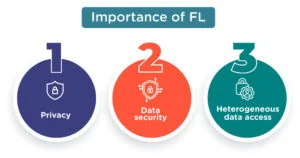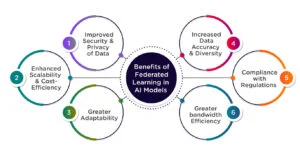What if your data could be used to train AI models? The strength of federated learning (FL) lies in that! This innovative method makes sure your data stays secure while developing more intelligent and effective solutions. FL combines state-of-the-art technology with data protection to bring innovation without compromising.
Are you interested in how it is changing the AI era? Let's do some exploring!
What is Federated Learning (FL) and Why is it Important?
Federated learning is a decentralized method for training machine learning models. It is also sometimes called collaborative learning. Global servers do not need to communicate data with client devices. Data privacy is increased by training the model locally using the raw data on edge devices. Together, the local modifications are aggregated to create the final model.
FL is used to train federated AI models. Such models maintain data security and privacy by keeping classified information safe, sustaining advanced predictive abilities.
Importance of FL:
1. Privacy: Federated learning prevents possible data breaches by enabling training to take place locally on the edge device, as opposed to traditional approaches that send data to a central server for training.
2. Data security: To ensure data security, only the encrypted model changes are sent to the central server. Furthermore, encrypting just aggregated data is possible with safe aggregation techniques like safe Aggregation Principle
3. Heterogeneous data access: Federated learning ensures that data dispersed across several devices, locations, and organizations may be accessed. While preserving confidentiality and privacy, it enables the training of federated AI models on sensitive data, like financial or medical data. Additionally, more diverse data allows models to be made more broadly applicable.
How does Federated Learning Work?
At the central server, a general baseline model is kept. Copies of this model are sent to the client devices, which use the local data they provide to train the models. Individual gadgets' models gradually become more customized and offer an improved user experience.
Next, using safe aggregation techniques, the primary model at the central server receives the updates (model parameters) from the locally trained models. In order to provide new learnings, this model averages and integrates several inputs. The data is gathered from a variety of sources, which increases the likelihood that the model will be broadly applicable.
For the following iteration, the central model is shared with the client devices once it has been re-trained on fresh parameters. The models continue to develop and collect a variety of data with each cycle, all while protecting privacy.
Benefits of Federated Learning in AI Models
#1 Improved Security and Privacy of Data
The collaborative nature of FL allows it to train models without sending the raw data, using every IoT device at the edge as a separate client. Essentially, each IoT device only collects the data required to accomplish its purpose during the FL process.
FL minimizes the chance of personal data leaks, preserves private raw data, and ensures operational security by storing raw data locally on the device and only sending model changes to the central server.
#2 Enhanced Scalability and Cost-Efficiency
More data in data science translates into stronger models. Even yet, training a model with large datasets might take a while if they are all kept on a single server or cloud.
Federated learning speeds up AI and IoT deployment models and increases operational scalability by enabling the parallel training of models on various datasets in many locations.
The amount of data that must be sent to a network and processed in the cloud is also decreased by orders of magnitude thanks to FL, which trains the model at the edge and only moves the trained weights.
In this way, it lowers computer and storage expenses and does away with the expense of large data transfers.
#3 Greater Adaptability
Federated learning models may typically be used in novel contexts without requiring retraining since they are able to learn from past events and provide predictions based on them. Furthermore, this learning approach may transfer the information and advancement it gains from one sector to another.
For instance, if the model gains better prediction skills in one area, it may use that information to increase productivity, lower expenses, and speed up the process in another.
#4 Increased Data Accuracy and Diversity
The whole range of data that the model will be applied to may not be fully represented by the data used for model training.
However, training the models on decentralized data from several sources and exposing them to a greater variety of data might enhance the model's capacity to manage differences, generalize new data, and lessen bias.
#5 Compliance with regulations
Federated learning makes it easier for companies to adhere to data protection regulations such as the General Data Protection Regulation (GDPR) by preventing the centralization of data. For international businesses, where data movement across borders can be legally difficult and risky, this is especially crucial.
#6 Greater bandwidth efficiency
The fact that federated learning eliminates the need for extensive data transfers between clients and servers is one of its biggest benefits. This is crucial in situations where bandwidth is limited, or data transfer expenses are an issue.
The main benefit of federated machine learning is that it maximizes network utilization, which is crucial for companies with constrained network capacity.
Federated Learning - Where Innovation Meets Privacy
Federated learning contributes to the promising future of AI models. FL provides unparalleled efficiency and security by training models locally and protecting your data. Better technology isn't the only thing at stake; establishing credibility and producing outcomes are also important. Businesses who adopt this innovation are opening the door to a safer and more effective AI future for everybody.
For more information on machine learning and on technology, keep visiting us at KnowledgeNile.
Read More:
Exploring Data Augmentation Techniques and Their Importance in Machine Learning
A Timeline of OpenAI’s Technology and History: How OpenAI Changed the World







